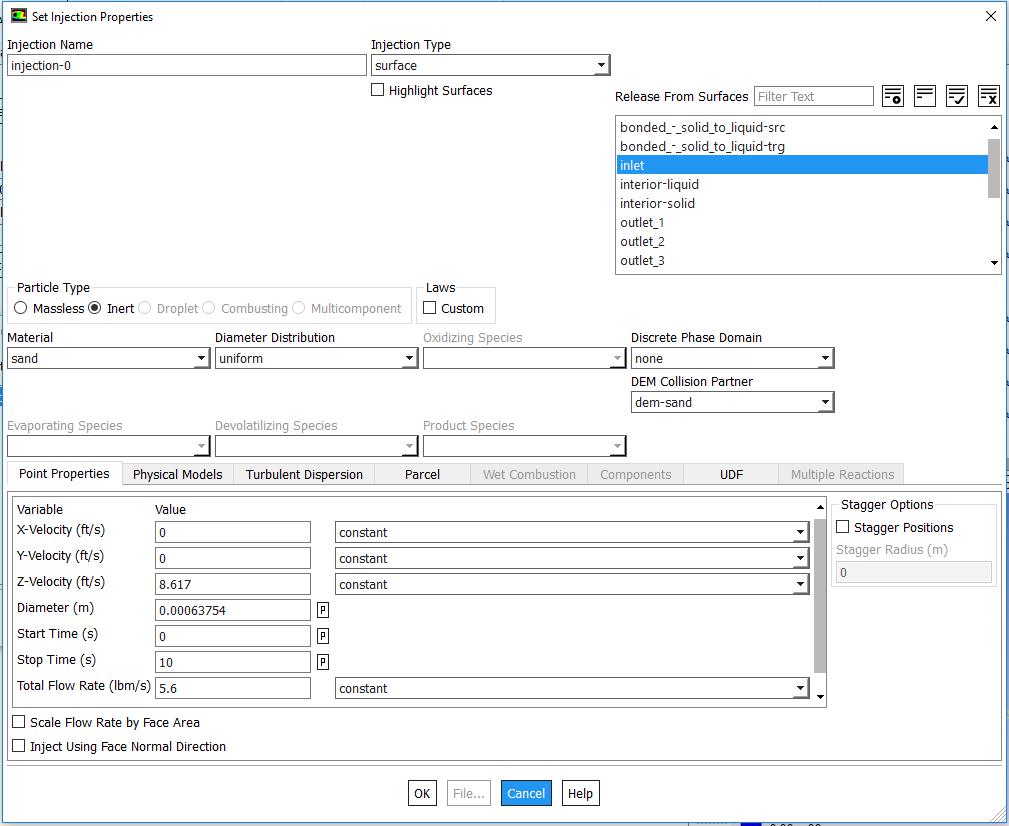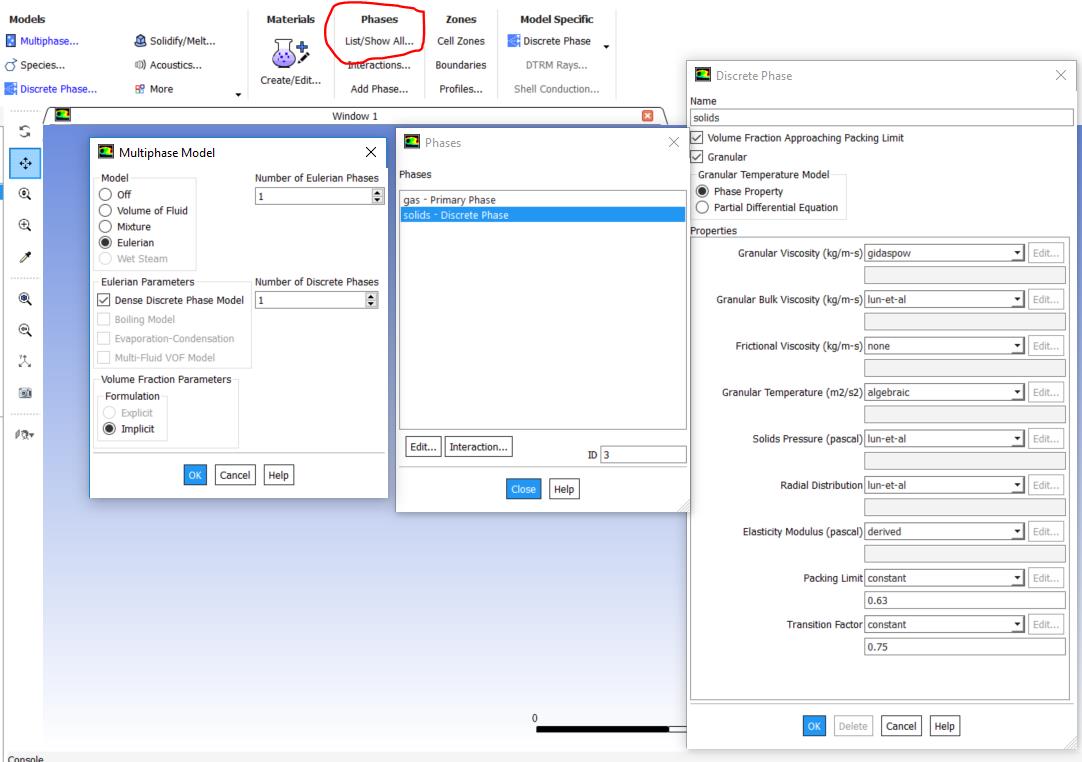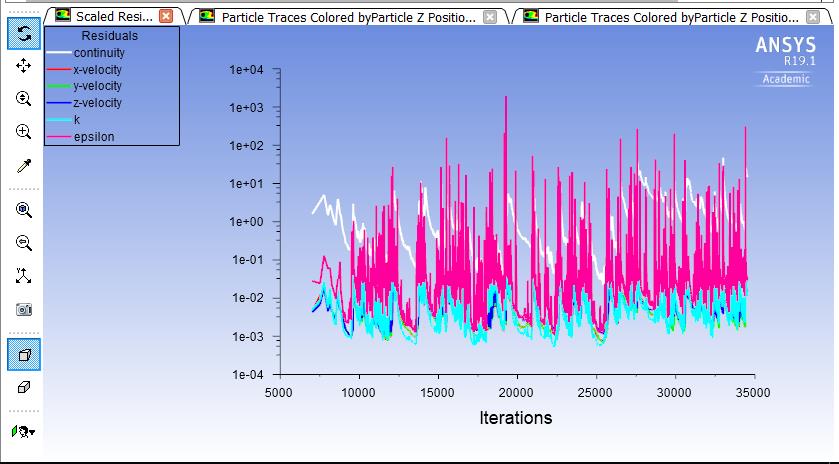-
-
October 20, 2018 at 3:25 pm
almulhem_900
SubscriberHi everyone,
I'm trying to model the flow of water and sand in 3D pipe with three side openings ( perforations) as shown in the following picture. The three holes are marked with the letters (A,B,C) and the other side of the pipe near hole C is plugged. The first objective is to estimate how much sand will escape from each hole.
Case Parameters:
Inlet (velocity-inlet B.C) with velocity = 8.617 ft/sec and reflect DPM B.C
outlet (pressure outlet B.C) with 0 gauge pressure and escape DPM B.C
Sand Injection is at the inlet face at the same velocity of the fluid (8.617 ft/sec) at flow rate of (22.4 lb/sec)
I'm having difficulty to get a converged solution using DPM without DEM collision and with steady particle tracking. Allowing DEM collision and tracking the particle in unsteady mode seems to be easier to get a converged solution but I have not gotten any yet.
Here are some questions I have:
- With such dense particle concentration will the DPM work ? or it is still considered to be a dilute fluid ?
- How can I model this problem using DDPM-DEM ? is the right model to handle such case ?
- Any tips to reach a convergence ( particle time step size, number of time steps, tracking parameters, Parcels, etc.... )
Thanks for your help
-
October 21, 2018 at 1:45 pm
Karthik Remella
AdministratorHello,
To answer your question in general terms - DPM generally works well when your dispersed phase is dilute (volume loading ~ 10%). In case of DDPM, this volume loading is much larger and the model is preferred for modeling particulate flows. A note of caution - DDPM takes into account particle-particle collision and there are really two different approaches - 1. using kinetic theory of grannular flow (KTGF), and 2. Discrete element modeling. KTGF models particle-particle interaction using an approximate grannular theory while DEM explicitly resolves these particle-particle interactions.
Regarding steady vs. unsteady particle tracking, please take a look at this screenshot below (ref - Fluent Users Guide, R18.2, Chapter 23: Modeling Discrete Phase).
Please use this information to select a modeling approach based on the problem you are attempting to solve.
Thank you.
Best Regards,
Karthik
-
October 21, 2018 at 10:42 pm
almulhem_900
SubscriberThanks Karthik for the reply.
I'm currently trying to run DEM with interaction between fluid and particles and it automatically switches to unsteady tracking. The question is how can I tell Fluent to simulate particles using DDPM? is there any specific button/window to enable it or DDPM is active when DEM collision model is selected? .
Please see below snapshots of an attempt to run DEM for the above problem.It is a very slow simulation. Is that normal for the case parameters? any suggestions/tips to make the case faster and reach convergence ? this case has been running for around 6 hours so far.
Thanks again for your help
-
October 22, 2018 at 5:55 am
Amine Ben Hadj Ali
Ansys EmployeeTo use DDPM you need to enable it under Multiphase Panel (as It a hybrid approach). Then in the injection panel check if the "Discrete Phase Domain" corresponds to the DDPM (secondary) phase
-
October 22, 2018 at 6:31 am
-
October 22, 2018 at 3:10 pm
-
October 22, 2018 at 5:03 pm
Amine Ben Hadj Ali
Ansys EmployeeEither KTGF or DEM for particle particle interactions within the DDPM framework. The particles are tracked by solving ODE's as you want.
-
October 22, 2018 at 5:31 pm
almulhem_900
SubscriberThanks Amine,
Are both KTGF and DEM with DDPM framework you are referring to are using Lagrangian ? Can you show me where can I specify those models?
Best regards,
Abdul
-
October 22, 2018 at 6:55 pm
Karthik Remella
AdministratorHello,
Yes, both are lagrangian. If you are interested in the difference, please refer to my previous post.
Enabling KTGF: This can be done from the secondary phase. Please see the screenshot below.
Enabling DEM: DEM can be enabled from the Discrete phase options under Models. Select DEM collisions from Physical Models. Please see the attached screenshot.
I hope this helps.
Best Regards,
Karthik
-
October 27, 2018 at 5:29 pm
almulhem_900
SubscriberHere is a DPM case that I'm trying to solve.
I get a convergence when I use a 0.15 lb/sec mass flow rate as shown below:
When I increase the mass flow rate to 1.5 lb/sec (at iteration 1500), the solution does not converge and I get "floating point exception" as shown below:
This is the way I setup the DPM:
Can someone help me with solving this issue ?
-
October 28, 2018 at 10:57 am
Amine Ben Hadj Ali
Ansys EmployeeSwitch on update DPM source every iteration, increase number of continuous iterations per DPM and reduce DPM Underrelaxation and run for much more iterations: first steps to sort problems out.
ps: even the case at low loading the run is not converging at all from residual perspective
-
October 29, 2018 at 12:54 am
almulhem_900
SubscriberThanks Amine.
This is the status of an ongoing re-run of the high loading particles (1lb/sec) with the parameters you suggested. I'm using a 0.3 underrelaxation for DPM.
it is now around 35k iterations and still there is no convergence. Do you think it needs more iterations to converge ?
The following snapshot is for the early time. 0.15 lb/sec particle flow rate until 2000 iterations. is this still not converged for the low loading using 1e-3 residual criteria ?
Thanks again and best regards,
-
October 29, 2018 at 6:31 am
Amine Ben Hadj Ali
Ansys EmployeeThat is kind of non-converging case. Can you please describe a bit your case and share with us all information regarding boundaries, settings and co?
-
October 29, 2018 at 2:30 pm
almulhem_900
SubscriberHello Amine,
The case tries to simulate the flow of water + sand along a pipe that is plugged from the outlet side and perforated on the sides as shown below:
Pipe length: 1 ft
Pipe diameter: 4.3 in
Perforation diameter: 0.38 in
Quadratic Meshing (400k nodes) with program controlled inflation layer as shown below:
BC:
Inlet: velocity inlet with 2 ft/sec. DPM BC: reflect
Holes: outlet vent with 0 gauge pressure . DPM BC: escape
Plug: stationary wall DPM BC: reflect
Coupling:
DPM as shown below:
Let me know if you need additional info
Thanks,
Abdulraof
-
October 29, 2018 at 2:45 pm
Amine Ben Hadj Ali
Ansys EmployeeHow big is the particulate volume fraction? Can you make any estimation? Can you obtain a converged case without DPM?
-
October 29, 2018 at 2:49 pm
almulhem_900
SubscriberIt is around 7% volume fraction
I did obtain convergence without introducing particles -
October 29, 2018 at 3:03 pm
Amine Ben Hadj Ali
Ansys EmployeeSo you need to find now a biasing between the DPM Source Terms URF and number of update.
You can run transient for enhanced stability. 7% Volume fraction at high mass loading requires the resolution of particle-particle interaction but you can tackle that stage after you are able to run a fine DPM run.
Are you accounting for buoyancy effects?
-
October 29, 2018 at 3:45 pm
almulhem_900
SubscriberI'm eventually will use either DEM or DDPM to include particle-particle interaction.
Do you mean transient fluid flow or transient particle tracking ?
I think I'm not accounting for buoyancy yet.
Thanks
-
October 29, 2018 at 3:50 pm
Amine Ben Hadj Ali
Ansys EmployeeBoth: Transient flow with transient particle tracking. I guess your continuous flow implies a sort of swirl which affect the particles and the latter start consuming the TKE of the continuous flow and the mean energy.
-
- The topic ‘DPM or DDPM-DEM to model flow of water and sand particles in pipe ?’ is closed to new replies.


- air flow in and out of computer case
- Varying Bond model parameters to mimic soil particle cohesion/stiction
- Eroded Mass due to Erosion of Soil Particles by Fluids
- I am doing a corona simulation. But particles are not spreading.
- Guidance needed for Conjugate Heat Transfer Analysis for a 3s3p Li-ion Battery
- Centrifugal Fan Analysis for Determination of Characteristic Curve
- Issue to compile a UDF in ANSYS Fluent
- JACOBI Convergence Issue in ANSYS AQWA
- affinity not set
- Resuming SAG Mill Simulation with New Particle Batch in Rocky

-
3892
-
1414
-
1241
-
1118
-
1015

© 2025 Copyright ANSYS, Inc. All rights reserved.



























